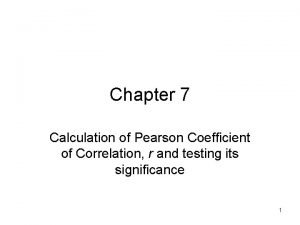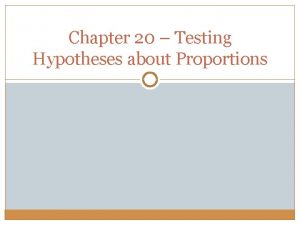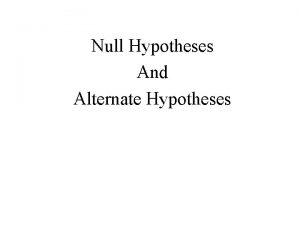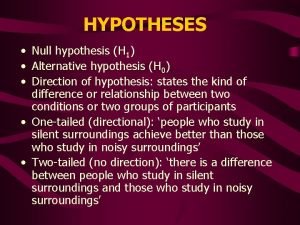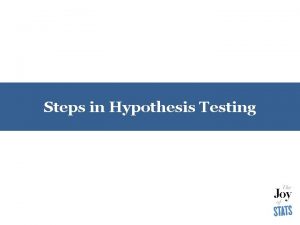Hypothesis Testing A Primer Null and Alternative Hypotheses






- Slides: 6

Hypothesis Testing – A Primer

Null and Alternative Hypotheses in Inferential Statistics • Null hypothesis: The default position that there is no relationship between the variables examined • Alternative Hypotheses: (1) A relationship of an unspecified direction (2 -tailed) OR (2) A positive relationship (1 -tailed) OR (3) A negative relationship (1 -tailed)

Type I and Type II Errors • What is the chance that you will reject the Null Hypothesis when it is in fact true? (Type I) • What is the chance that you will fail to reject the Null Hypothesis when it is in fact false (Type II) • Note 1 : rejecting the Null Hypothesis in favour of the Alternative Hypothesis in NOT the same as “proving” the Alternative Hypothesis true • Note 2: Watch for the value judgement soon to be inserted…

Which error will you choose to minimize? What will be the strength of the evidence you require? Innocent before proven Guilty The trade-off (but this illustration is a bit misleading since the evidence in a jury trial is not obtained from a simple random sampling method) Truth (for population studied) Reject Null Decision (based on Sample) Fail to Reject Null Hypothesis True Null Hypothesis False Type I Error Correct Decision Type II Error H 0: accused Not Guilty HA: accused Guilty Verdict Not Guilty Truth Not Guilty Innocent person convicted Correct Decision Guilty person goes free

Trade-offs • “We cannot prove this Person is guilty” is not the same thing as “This Person is innocent” • The researcher must decide on the strength of the evidence needed to “reject” or “not reject” the Null Hypothesis H 0 (i. e. , that there is no relationship) • Given the structure of the test, rejecting H 0 must mean the strength of the evidence supports (but does not prove) HA (i. e. , evidence supports the proposed relationship) • As a researcher, what strength of the evidence will you require? The higher the bar you set for the evidence to accurately assess H 0 the lower the chance you have of committing a Type I error (reject H 0 when it is true)…and then the greater the chance you will commit a Type II error (finding evidence incorrectly that suggests support for HA )

Significance Levels • The significance level = α (either. 01/. 05/. 10 or 1% - 5% - 10%) is the …rate of falsely rejecting H 0 …rate of committing a Type I error …the number of times out of 100 that one will reject H 0 when it is in fact true (1/100; 5/100; 10/100) …strength of the evidence, where α = 10% is a lower bar than α = 5% (since the strength of the evidence needed to reject H 0 at 10% is less than the strength of the evidence needed at 5%) …researcher’s choice and should be informed by the consequence of Type I or II errors


